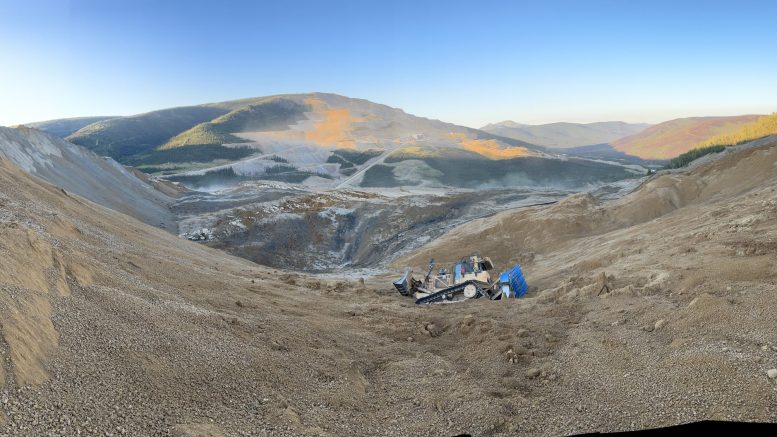A heavy equipment operator who was caught in the heap leach pad accident at Victoria Gold’s (TSXV: VGCX) Eagle mine in Yukon says he fears the company may try to downplay the scale of the disaster.
About 4 million tonnes of ore, representing about 10% of the total on the pad moved during the June 24 accident, Victoria has said. Of that, about 2 million tonnes moved beyond the pad’s embankment.
Victoria has issued three news releases since the accident on June 24, and has not responded to multiple requests for comment by The Northern Miner.
“Whether it’s a lockout violation, or a previous (heap leach) slide, or (an overland conveyor) belt slipping – you name it. They cover it up,” the operator claimed. He said that a smaller heap leach slide occurred in January, and a safety stand-down that should have taken place never occurred.
He also said that the company didn’t follow proper safety stand-down protocol following an accident with an overland conveyor belt, which happened in May. The operator, who participated in the repair work, claims the company didn’t conduct an investigation into the incident, which would normally be required for large repair efforts, and which would entail post-incident interviews with the involved workers.
The Northern Miner has agreed not to name the worker. However, the company would be aware of his identity through a Workers’ Safety and Compensation Board (WSCB) claim he has filed for neck injuries and post-traumatic stress disorder.
Two other individuals who worked at Eagle have also come forward to describe alleged safety lapses at the operation.
Video shot by the operator near the top of the pad
Operations were suspended at Eagle, Yukon’s only producing gold mine, after the company reported that a failure at its heap leach pad caused an accident and spill that damaged some infrastructure. Damage was sustained to the pad’s embankment, piping, pumping, liner, conveyors and some electrical infrastructure, Victoria said in a news release Friday, its third since the accident. Victoria shares plunged more than 85% during the last week of June. The company’s market cap is now $62.9 million. The mine is about 375 km north of Whitehorse.
Victoria acknowledged on Friday there’s no assurance it will be authorized to resume production or that it will have enough cash to repair the damage at Eagle, remediate the accident’s effects or restart production. The company has received notices of default from its lenders under a credit agreement from Dec. 18, 2020, it said last week. Its first quarter financial report this year states its debt payments total $232.5 million as of March 31.
‘I braced for impact’
The operator, who has been working at Eagle for two years, says he was inside his bulldozer and on top of the leach pad around 5:30 a.m. on June 24. The primary leaching pad can accommodate as much as 90 million tonnes of ore, and about 38.9 million tonnes was stacked on the pad since production started, Victoria said Friday.
A haul truck was driving on the pad towards him, when he felt the ground move and saw to his right that the ore under the pad was splitting and cracking, he says.
He tried reversing the bulldozer, but the collapsing pad pulled him down.

An overland conveyor belt is damaged from the landslide. Submitted photo
“I needed to hold on because when I started sliding down the mountain it was very steep. I braced for impact and slid down the side of the mountain about 200 metres,” he said.
When his bulldozer stopped sliding, it was tipped 45 degrees on its side. He grabbed his backpack and cell phone and got out.
He tried clambering across the slope, but more gravel-size ore slid down, almost burying him. He managed to clamber up to a small rock shelf. He radioed his supervisor and, fearing his crew was killed, was relieved to hear that everyone was accounted for.
He climbed further up the slope to a second shelf and sat down. When it began to slide, he continued climbing until he reached an intact part at the top of the pad.
‘Company didn’t ask’
Another supervisor radioed him and said he saw him on the pad, he says. An ambulance picked him up and drove him down to the main camp below. He was given light medical attention, though he said his injuries are minor. He’s not concerned about cyanide exposure because he said none of his skin made contact with the material.

A view of the landslide from near the top of the pad. Submitted photo
“I was tossed around in the dozer,” he said. “It was a violent ride on the way down. I smacked my head a couple times. I probably strained a muscle in my neck. I’m going for neck X-rays this week to make sure none of the vertebrae in my neck are injured.”
He wasn’t taken to a hospital and no one from Victoria Gold asked him if he was okay, he said.
The Yukon government reported a week earlier that one person sustained non-serious injuries in the accident, and two received first aid treatment. Victoria said in its release last Thursday that there were no injuries in the accident. The operator said he’s not aware of anyone else who was injured.
When he returned to his trailer and tried to text his family, he found the internet was cut, and most of the land lines. He eventually found a line in the office of a different department and reached his family.
Caused by over-leaching?
An investigation is ongoing to determine the accident’s cause and Victoria is cooperating with third party technical experts from the Yukon government and the First Nation of Na-Cho Nyäk Dun, it said on Friday.
While the operator acknowledges he’s not an engineer, he believes the accident was caused by excessive leaching of the ore and improper maintenance of the leach pad.
He claims that pipes carrying the cyanide-bearing solution throughout the pad would break and nobody fixed them. Cyanide is used to separate gold from ore.
Hundreds of layoffs
The operator said all staff were laid off on June 25 and 26, though Victoria hasn’t confirmed that. The mine employs about 500 people.
The Yukon government said last week that the company reduced on-site staff to 60 essential workers while water treatment and pumping of water into storage ponds was ongoing.
The operator is now at home in British Columbia, and has filed a WSCB claim for neck injuries and post-traumatic stress disorder.
He received his latest pay from Victoria on Thursday, but said he’s missing almost 18 hours worth of pay.
“They shorted us a couple hours on the landslide day,” he said. “Everyone was supposed to work the next day. They never paid us for that day.”
He said he doesn’t plan to return to Victoria Gold.
“I’m going to take the summer to decompress,” he said. “I’m not myself. I’m not at the gym or trail running. I don’t know if I ever want to go back to mining.”
— This story has been edited since publication. Some quotes used in the original story have been paraphrased and additional details have been added.






This is a pretty serious set of issues and items to unpack here. Number 1 is the safety of staff and communications, care, and management engagement with the staff. Number 2 is why did this worker and others not raise these issues earlier, over the years? There are forums for this and methods inside the company and elsewhere. Number 3, How can communications with a site in an emergency be cut? This is a very serious level of “issue” about the management and awareness of responsibility .. if found to be the actual sequence of events. Was thee a Mayday, Mayday, Mayday … or similar stress call. Was mine resue alerted .. ?
Cursory data show the odd establishment of an HL in that area in 2017, the large BASIn for collecting the lixiviant and pregnant solution, and the steady and quite significant stacking vertically and continually for 7 years ….
Massive snowfall in 2021/22 and the ongoing use of solution, thereafter meant that there was significant moisture in the mix, and between lifts. Also evident in the ponding of the lifts across time and seasons. Whether that was “designed in” to the plan and construction of the HL … will be a question for the engineers. The climate and thermal/precipitation issues are considerations that will affect current, and future HL projects — as well as any FIX to this one that is possible — with tons of material laced with broken array of lixiviant piping ….
If you are mining rock through the winter is the crushed rock frozen ? What happens to the water cynanide solution when it combines with the frozen material ? Does it become slippery on a slope .Just some simple questions from an old catskinner.